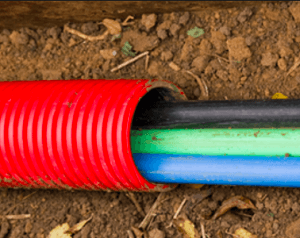How Much Does it Cost to Bury Power Lines?
Last Updated on July 13, 2025
Written by CPA Alec Pow | Content Reviewed by ![]() CFA Alexander Popinker
CFA Alexander Popinker
Underground circuits hide the wires, cut wind-borne outages, and boost curb appeal, yet the price stretches far beyond a simple trench. Installation expenses, future maintenance, and utility fees can triple an initial budget if planners skip the fine print.
Undergrounding costs swing from $10 to $25 (≈1.7 hours of labor required at $15/hour) per foot on a single-home service drop to $4 million (≈128.2 years of non-stop labor earning $15/hour) per mile on dense urban feeders, with transmission retrofits vaulting higher. Soil, conduit diameter, voltage, and permitting stack line-item fees fast, so this guide unpacks every factor—residential, neighborhood, and commercial—plus real invoices, hidden charges, and proven savings tactics.
Article Highlights
- Residential runs cost $10 (≈40 minutes working at a $15/hour wage)–$25 (≈1.7 hours of labor required at $15/hour) per foot, or $5,000 (≈1.9 months of your working life at $15/hour)–$12,500 (≈4.7 months trading your time for $15/hour) for 500 ft.
- Urban distribution feeders climb to $297,000 (≈9.5 years devoted to affording this at $15/hour)–$4.5 million (≈144.2 years of labor at $15/hour) per mile.
- Underground is typically 4–10 × the price of overhead build.
- Conduit and trench work consume about 65 % of any project budget.
- Soil hardness, permit fees, and utility policy swing totals by thousands.
- Group projects, grant funds, and off-season bids can shave 15–30 %.
How Much Does it Cost to Bury Power Lines?
We found that burying a 500-foot residential lateral runs $5,000 (≈1.9 months of your working life at $15/hour)–$12,500 (≈4.7 months trading your time for $15/hour), averaging $12,250 (≈4.6 months trading your time for $15/hour) when a contractor supplies conduit and pulls #2-AWG aluminum. Overhead service for the same home lands near $4,000 (≈1.5 months of non-stop employment at $15/hour)–$7,500 (≈2.8 months trading your time for $15/hour), proving undergrounding costs roughly twice as much on short runs. Urban feeder conversions jump to $297,000 (≈9.5 years devoted to affording this at $15/hour)–$4.5 million (≈144.2 years of labor at $15/hour) per mile, while rural upgrades hover near $2 million (≈64.1 years of dedicated labor at $15/hour) per mile because crews trench through softer ground and secure cheaper easements.
Utilities also bill a one-time connection fee—typically $750 (≈1.3 weeks of non-stop employment at $15/hour)–$1,500 (≈2.5 weeks of non-stop employment at $15/hour)—to splice buried conductors into the existing grid. Choosing underground over overhead delays pole-maintenance expenses, yet higher capital outlay raises monthly tariffs in some jurisdictions. Policy nuances matter: Arizona’s Gateway Corridor study pegged buried feeders at 4.8–6.8 × overhead cost, strongly shaping its route decision.
According to Renewable Energy World, the cost to underground existing overhead distribution infrastructure can range from $350 to $1,150 (≈1.9 weeks of continuous work at a $15/hour wage) per foot (or $1.85 million to $6.1 million (≈195.5 years of non-stop labor earning $15/hour) per mile) depending on the utility and specific project requirements. For example, PG&E estimates costs between $650 and $1,150 (≈1.9 weeks of continuous work at a $15/hour wage) per foot, while SCE reports $351 to $990 (≈1.7 weeks working without a break on a $15/hour salary) per foot. These figures include all aspects of the undergrounding process, such as trenching, conduit, cabling, connections, and removal of overhead infrastructure. For high-voltage transmission lines, the cost can be even higher, reaching up to $33 million (≈1057.7 years of non-stop labor at a $15/hour job) per mile in some cases.
On a smaller scale, HomeGuide reports that the average cost to run new underground power lines for residential or small commercial projects is typically $10 to $25 (≈1.7 hours of labor required at $15/hour) per foot, or $5,000 to $12,500 (≈4.7 months trading your time for $15/hour) for a 500-foot run. This cost includes materials and labor but may not cover additional expenses such as permits, trenching, or conduit installation, which can add to the total price.
Illinois Country Living highlights that burying power lines is generally five to ten times more expensive than installing overhead lines, with rural projects averaging nearly $500,000 (≈16 years working without vacations at a $15/hour job) per mile. For high-voltage transmission, costs can soar to $23 million (≈737.2 years of non-stop work earning $15/hour) per mile, making undergrounding a rare choice for such infrastructure.
According to ThePricer.org, homeowners can expect to pay $7 to $10 (≈40 minutes working at a $15/hour wage) per foot to have a qualified contractor or electric company bury residential power lines, with average projects for homes less than 250 feet from the road costing $2,700 to $5,700 (≈2.2 months working without a break on a $15/hour salary). These estimates may not include trenching or conduit costs, which are often billed separately.
Bluetti Power provides a similar estimate, stating that burying existing power lines typically costs $5 to $20 (≈1.3 hours of your life traded for $15/hour) per linear foot, depending on the length and location of the project.
For large-scale municipal or utility projects, CNN notes that the industry rule of thumb is at least $1 million (≈32.1 years working without vacations at a $15/hour job) per mile for burying lines, with costs rising much higher in urban or complex environments.
Real-Life Cost Examples
We examined three documented jobs. A Wisconsin homeowner converted a 120-foot service; trenching, conduit, and 200-amp riser totaled $8,900 (≈3.4 months of your working life at $15/hour), but rock saw rental added an unplanned $640 (≈1.1 weeks of continuous work at a $15/hour wage).
The town of Bluffton, South Carolina, buried 1.4 miles of 13-kV line for streetscape upgrades. Palmetto Electric’s contractor billed $1.96 million (≈62.8 years of dedicated labor at $15/hour)—$1.4 million (≈44.9 years of your professional life at $15/hour) civil, $560,000 cable and switchgear. Residents approved a special assessment district to repay $9,700 per parcel over ten years.
On the commercial side, Tucson Electric Power’s Midtown Reliability Project estimated $15–$27 million per mile for a 138-kV retrofit using forced-air pipe cable under a state highway. The utility eventually chose a hybrid overhead-and-tunnel design to trim the budget. These diverse cases show how distance, voltage, and right-of-way dictate the final price tag.
Cost Breakdown
Table 1. Typical Share of Undergrounding Expenses (Residential 500 ft)
| Component | % of Total | Typical Cost |
| Conduit & Cable | 35 % | $2,800–$4,000 |
| Trenching & Backfill | 30 % | $2,400–$3,600 |
| Labor & Equipment | 18 % | $1,400–$2,200 |
| Permits & Inspections | 7 % | $500–$900 |
| Utility Connection | 10 % | $750–$1,500 |
Materials start with Schedule 40 PVC or HDPE conduit, copper or aluminum conductors, and weather-rated pull boxes. Labor escalates on rocky sites that need rock saws or hydro-vac trucks. Restoration—sod, asphalt, or pavers—adds $3–$12 per square foot. Municipal reviewers collect plan-check and inspection fees, while utilities charge meter-base relocation and energization rates. These slices vary, yet the conduit-plus-trench duo often eats two-thirds of the entire budget.
Factors That Push Costs
We found five dominant variables. Soil type tops the list: sandy loam digs twice as fast as granite, trimming excavator hours and install price. Distance and required depth follow; NEC mandates 24-inch cover for 120/240-V residential circuits but 36 inches or duct banks for higher voltages, doubling spoil haul-off.
You might also like our articles on the cost of stop signs, traffic lights, or telephone poles.
Third, local permits: dense metros demand traffic control plans, lane-rental fees of $5,000–$10,000 per day, and night work premiums. Fourth, utility policy: some co-ops subsidise residential undergrounds during pole replacements, slicing private cost by 50 %. Finally, material inflation—copper up 12 % in 2024—raises conductor quotes (give or take a point). Technology offsets help; cross-linked polyethylene (XLPE) now replaces oil-filled cable, shrinking vault counts and labour.
Lower-Cost or Hybrid Solutions
 We compared improved overhead poles, covered conductors, and micro-trenching. Hardened-wood or composite poles plus tree-trim cycles cost $79,000 per mile—roughly one-fiftieth of premium 138-kV underground—yet still risk storm knocks. Covered conductors insulate wire but leave them aloft; they lower wildfire sparks for 20–30 % of undergrounding outlay.
We compared improved overhead poles, covered conductors, and micro-trenching. Hardened-wood or composite poles plus tree-trim cycles cost $79,000 per mile—roughly one-fiftieth of premium 138-kV underground—yet still risk storm knocks. Covered conductors insulate wire but leave them aloft; they lower wildfire sparks for 20–30 % of undergrounding outlay.
Micro-trenching cuts a 4-inch slot in pavement, dropping single-phase cable for $6–$10 per foot, good for street-lighting or broadband but limited to 15-kV loads. Tunnel boring, championed by new tech firms, advertises $10 million per mile all-in for multi-utility corridors—mid-way between duct banks and overhead. Each option balances expense, reliability, and aesthetic goals; mixed networks often yield the best life-cycle value.
Ways to Spend Less
We found four proven tactics. First, coordinate with neighbours: group undergrounding splits mobilisation fees; Washington neighborhoods saved 18 % by bundling six homes under one permit. Second, supply trench labour or conduit where codes allow—DIY digging trimmed one Kansas farm’s quote from $11,400 to $7,900. Mark Novak, PE at Midwest Energy, cautions: “Homeowners must match utility specs or risk a failed inspection.”
Third, schedule off-season installs; contractors cut 10–15 % when winter bids slow. Fourth, chase subsidies: FEMA’s BRIC grants cover up to 75 % of wildfire-mitigation undergrounds in declared zones, slashing municipal expenses. Dr Linda Clarke, grid-resilience researcher at NREL, notes grant windows widen yearly as climate risks climb.
Answers to Common Questions
Does undergrounding eliminate outages?
It reduces wind and tree faults, yet dig-ins and insulation failures still happen—and repairs take longer underground.
Can I trench my own line to lower cost?
Yes where codes allow, but utility inspectors must approve conduit depth, material, and bend radius before energizing.
Are underground cables safer near wildfire zones?
Studies by California’s PUC show a 97 % drop in vegetation contacts on buried feeders, cutting ignition risk dramatically.
Why do high-voltage retrofits cost tens of millions per mile?
Heat dissipation demands pressurized pipe or tunnel systems, plus multi-million-dollar splice vaults every 1,500 ft.
Will utility bills rise after city-wide conversion?
Often yes; many utilities add rider charges to recoup capital over 20–30 years, though reliability gains offset some rate impact.

Leave a Reply
Want to join the discussion?Feel free to contribute!